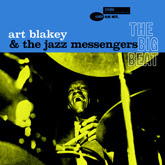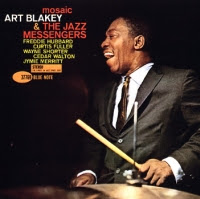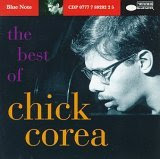 An all-star aggregation put together by Sabin and Nick Phillips of Concord Jazz, the JazzTimes Superband stands as a testament to the chemistry and high level of musicianship of all the players involved -Randy Brecker on trumpet, Bob Berg on tenor saxophone, Dennis Chambers on drums, Paul Bollenbeck on guitar and Joey DeFrancesco on Hammond B-3 organ. With virtually no rehearsal time, this abundantly talented crew gathered in the studio and tackled a set of forcefully swinging originals and two notable covers. The result was pure, unadulterated burn with plenty of virtuostic turns along the way.
An all-star aggregation put together by Sabin and Nick Phillips of Concord Jazz, the JazzTimes Superband stands as a testament to the chemistry and high level of musicianship of all the players involved -Randy Brecker on trumpet, Bob Berg on tenor saxophone, Dennis Chambers on drums, Paul Bollenbeck on guitar and Joey DeFrancesco on Hammond B-3 organ. With virtually no rehearsal time, this abundantly talented crew gathered in the studio and tackled a set of forcefully swinging originals and two notable covers. The result was pure, unadulterated burn with plenty of virtuostic turns along the way.
The remarkable chemistry heard on this hard-swinging session comes from the longstanding relationships that some of the playeres have had with each other over the years. Berg's connection to Brecker goes back to the early 1970s, when the two used to participate in loft jam sessions with the likes of Dave Liebman and another Coltrane-inspired tenor player named Michael Brecker.
"There was an organization that Liebman started called Free Life Communications" recalls Randy. "We were born in that and played together a lot in these days. I remember playing with Bob in lofts, at a few jam sessions and on a couple of record dates. And he was pretty close to my brother too. They'd practice together. So I've known him for a long time". Berg played on Brecker's bop-inspired quintet offering from 1991, Live at Sweet Basil, and subsequently toured with Randy's band, which also featured Dave Kikoski on piano, Dieter Ilg on bass and either Dennis Chambers or Joey Baron on drums. More recently, Brecker returned the favor by guesting with Berg's group on a number of gigs. The two also played side by side on Marc Copland's 1995 recording, Stompin' With Savoy, which featured Chambers on drums.
Brecker's history with Chambers includes a 1990 solo recording, Toe to Toe and two early 1990s recordings and subsequent tours with a reunited The Brecker Brothers band. Berg and Chambers first established their intense chemistry together in the powerhouse Bob Berg/Mike Stern band from the late 1980s, one of the first vehicles in which Chambers was able to showcase his stellar swing chops on a smaller jazz kit as opposed to the thunderous funk style he was so noted for in previous stints with Parliament-Funkadelic and John Scofield's fusion of the mid-80s. The saxophonist and drummer have collaborated on a number of recordings since that first encounter, including Berg's 1993 Stretch Records debut, Enter the Spirit.
"I don't get a chance to do this kind of straight ahead playing as much anymore" says the in-demand drummer who is also a charter member of the fusion power trio Niacin. "That's why I dove at the chance of doing this Superband project. My real love is more or less into the jazz, bebop, straight ahead kind of thing. I grew up doing that. I'm mostly known for my playing on the fusion side and the funk side, which I love too. But if I had a choice, I would just play straight ahead."
This Superband recording represents the first time that either Brecker or Berg have played with organ, great Joey DeFrancesco. As Randy explains "I may have played with Joey in Philly some years ago when he was still a kid. They have an Organ Night at the annual Mellon Festival and I did that a couple of times, so I probably played with him on one of those, but it was kind of from afar, so to speak."
While Berg had never played with DeFrancesco, his own musical roots are deeply entwined with the Hammond B-3 organ. "The professional jazz gig that I ever did was with Jack McDuff in 1969" he explains. "I was 18 and had never been on the road before but I grew up fast on that gig. Playing the organ circuit back then was really an eye-opening experience. So Joey's coming from kind of a familiar place for me. He's the real McCoy, the real deal. He plays the Hammond organ in that real tradition. So for me, it was pretty natural playing with him on this session."
Yet another harmonious hookup within the JazzTimes Superband is the longstanding relationship between DeFrancesco and guitarist Paul Bollenback, who was a regular in Joey's band throughout the 1990s and appears on a string of five superbly swinging Columbia recordings from that period. Bollenback's connection to Chambers goes back even further to a trio they had together in Baltimore during the early 1980s with bassist Gary Grainger, pre-dating Dennis' higher profile work with Scofield's group. DeFrancesco and Chambers first established their rhythmic rapport back in 1993 while working together in John McLaughlin's rollicking Free Spirits trio. With Joey's agile foot pumping the bass pedals while alternately waking basslines in the left hand and Dennis providing a propulsive momentum on the kit, they make a formidable rhythm team.
The album opens on a jaunty note with Randy Brecker's "Dirty Dogs", an earthy shuffle with allusions to Benny Golson's "Blues March". As the composer explains, "That was written recently in Japan while I was in the middle of an Art Blakey tribute band tour, so it has a little of that Jazz Messengers quality in it". Everybody gets a taste here, starting with a sparkling Brecker trumpet solo and followed by an intense Bob Berg tenor solo. Guitarist Paul Bollenback adds some bluesy statements of his own before Joey enters with his signature burn.
"Silverado" is a modern sounding number that Berg had previously recorded on his 1990 Denon album, Back Roads. This highly changed version is fueled by Chambers' insistent swing factor in tandem with DeFrancesco's surging bass pulse on the pedals. After navigating the harmonically involved head, Berg launches into a heroic tenor solo that bristles with fierce conviction. Randy gets off a brilliant solo here, sounding more Woody Shaw than Jazz Messengers. The energy level spikes with Joey's wicked solo, which leans more toward Larry Young territory than the blues-based stylings of Jimmy Smith, and Dennis traverses the kit with polyrhythmic aplomb at the tag.
"Jones Street" is another swinging Brecker offering which he had originally written for saxophonist Lew Tabackin and had previously recorded on an album by Tony Lakatos, a gifted Hungarian gypsy tenor saxophonist currently living in Frankfurt, Germany. Randy's vibrant energy here is matched by Joey's B-3 sizzle and Berg's gutsy tenor wail. Bollenback also contributes a far-reaching solo that stretches into some adventurous harmonic territory while remaining rhythmically in the pocket.
The Superband collectively wails with abandon on Sonny Rollins' "Oleo", a quintessential jamming vehicle that brings out the best in all the soloists. Chambers' playing is particularly astounding here as he plays the familiar melody on his kit before heading into hyperdrive with the ride cymbal, hi-hat and snare, setting a blistering pace for a string of incandescent solos to follow. Joey unleashes at this blazing tempo, flashing the fastest right hand in the business while walking furious basslines in his left hand. Randy follows with what amounts to a hard boppish rendition of "Flight of the Bumble Bee" then Berg turns in an astounding solo of his own, summoning up an intense torrent of power at such an impossible pace. Think Booker Ervin played at 45 rpms. The exchange of eights here with Chambers is absolutely white hot.
Berg's "Friday Night at the Cadillac Club" is greasy ribs-and-greens-eating fare harkens back to the saxophonist's formative years with B-3 organ great Jack McDuff. "The title refers to a place in Newark, New Jersey called the Cadillac Club, which was the first gig I had with the band" he recalls. "There were thre clubs at that one intersection. There was a place across the street called the Key Club and there was Jimmy McGriff's, which was an organ club too. At that time, I had been mostly checking out Coltrane and Miles, and here I found myself in a situation where I'm standing on a corner and anywhere I looked there were organ clubs. So we played this place and it was so different from anything that I had ever experienced. It was a lot of gangster types hanging out there and hookers. You know, players. Just really people I had never been around in my little neighbourhood in Brooklyn that I grew up in. It made such an impression on me that years later when I was writing music for the Short Stories record, I wrote this tune. It really brought to mind the feeling of that time -that shuffle kind of dirty bluesy thing. And I knew that would be an automatic for Joey". Berg turns in an appropriately blustery, big-toned solo here. Brecker outlines the harmony with his own adventurous solo while Joey digs into this lusty vehicle with fangs bared, offering another blues-drenched show-stopping turn on the B-3.
The moody "SoHo Sole" is Berg's nod to the innovative organ style of Larry Young. "One of my favorite records of all time is Larry Young's Unity" he says. "To me, that's the icon of organ quartet records. I just love that record, I remember hearing it when it came out. Larry played so hip on it and I loved the way Joe Henderson, Woody Shaw and Elvin Jones sounded on it too. So I was kind of thinking along those lines when I wrote this tune". Berg uses the harmonic implications of his own composition to launch into his most daring solo on the record while DeFrancesco pushes the envelope as well.
Brecker turns in some of his most dynamic playing on his own Latin flavored composition, "The Ada Strut", a tune he wrote on a bus in England while on tour with his brother Michael in honor of percussionist Don Alias's 60th birthday.
DeFrancesco's rousing "Blue Goo" is an angular mid-tempo blues line that he figured out in his head on the way to the session. Guitarist Bollenback explodes out of the block on his solo here, flowing with the kind of facility, rhythmic assuredness and harmonic inventiveness that have marked him as one of the most exciting jazz guitarists on the New York scene. Randy's swaggering solo statement on this blues bristles with sparks of spontaneous invention, Berg enters by echoing tha last four notes of Brecker's solo, develops the idea, and then launches into an inspired blues-drenched solo on top of the relaxed, swinging groove. Joey ups the ante, laying back at first before busting loose and frantically double-timing the tempo on his own exhilarating solo.
Bollenback contributes the evocative "Seven A.M. Special", a minor key blues he wrote while in the throes of jet lag after a return trip home from Japan.
The collection closes on an energized note with a free-blowing extrapolation on Eddie Harris' "Freedom Jazz Dance". The Superband pulls out all the stops on this chops-busting anthem.
The results of this all-star session are purely scintillating, as one can hear by cueing up any of the ten tracks at random. Savor the burn of their studio debut.
 The classic edition of Art Blakey's Jazz Messengers originally took shape at the Canadian Exposition in the summer of 1959 when Wayne Shorter, then a member of Maynard Ferguson's reed section, was recruited by Lee Morgan to substitute for an absent Hank Mobley. In the six months seperating that event and the recording of The Big Beat much had transpired. Shorter, with Morgan alongside, made his recording debut on Wynton Kelly's first Vee Jay album, which in turn led both horn players to sign contracts with the Chicago-based label. Pianist Bobby Timmons took what proved to be a brief leave of absence from the Messengers to help Cannonball Adderley launch his new quintet. It was the Timmons sanctified composition "This Here" that helped turn Adderley's new unit into an instant sensation. Blakey did bring the Messengers, with Walter Davis Jr. on piano, into Rudy van Gelder's studio on November 10 (the same day on which the Vee Jay album Introducing Wayne Shorter was completed); but the resulting Africaine was initially rejected by producer Alfred Lion because it lacked a track with the crossover potential of Timmons's earlier "Moanin'". The Messengers left for Europe immediately after the Africaine date, where they taped in various performances on their own and with guests such as Bud Powell. Meanwhile, Timmons signed a recording contract with Riverside and cut his composition "Dat Dere" twice -in a trio version for his This Here Is Bobby Timmons date in January, and in his final appearance with Adderley for the Them Dirty Blues album a month later.
The classic edition of Art Blakey's Jazz Messengers originally took shape at the Canadian Exposition in the summer of 1959 when Wayne Shorter, then a member of Maynard Ferguson's reed section, was recruited by Lee Morgan to substitute for an absent Hank Mobley. In the six months seperating that event and the recording of The Big Beat much had transpired. Shorter, with Morgan alongside, made his recording debut on Wynton Kelly's first Vee Jay album, which in turn led both horn players to sign contracts with the Chicago-based label. Pianist Bobby Timmons took what proved to be a brief leave of absence from the Messengers to help Cannonball Adderley launch his new quintet. It was the Timmons sanctified composition "This Here" that helped turn Adderley's new unit into an instant sensation. Blakey did bring the Messengers, with Walter Davis Jr. on piano, into Rudy van Gelder's studio on November 10 (the same day on which the Vee Jay album Introducing Wayne Shorter was completed); but the resulting Africaine was initially rejected by producer Alfred Lion because it lacked a track with the crossover potential of Timmons's earlier "Moanin'". The Messengers left for Europe immediately after the Africaine date, where they taped in various performances on their own and with guests such as Bud Powell. Meanwhile, Timmons signed a recording contract with Riverside and cut his composition "Dat Dere" twice -in a trio version for his This Here Is Bobby Timmons date in January, and in his final appearance with Adderley for the Them Dirty Blues album a month later.


